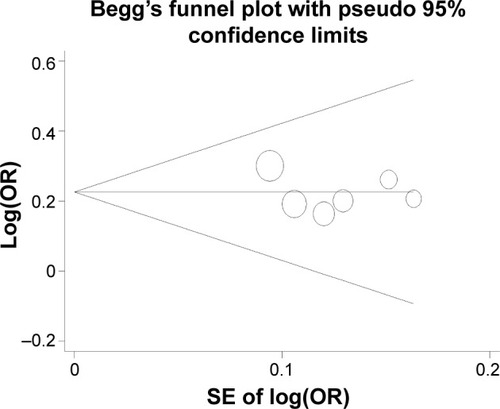Abstract
Background
The association between telomerase reverse transcriptase (TERT) rs2736098 G>A and risk of lung cancer (LC) remains inconclusive. To explore the association more precisely, we performed a comprehensive search and conducted a meta-analysis on all eligible case–control studies involving 3,354 cases and 3,518 controls.
Methods
The 95% confidence interval (95% CI) and the pooled odds ratio (OR) were calculated using a random or fixed effect model. Publication bias, heterogeneity, and sensitivity analysis were also explored.
Results
All studies were case–control studies on LC in patients of Asian descent, consisting of one Korean study and five Chinese studies. Overall, the variant A allele of TERT rs2736098 G>A was found to significantly increase the risk of LC in all genetic models (GA vs GG: OR =1.13, 95% CI =1.02–1.25, P=0.017; AA vs GG: OR =1.78, 95% CI =1.53–2.07, P<0.001; GA/AA vs GG: OR =1.25, 95% CI =1.14–1.38, P<0.001; AA vs GA/GG: OR =1.66, 95% CI =1.45–1.92, P<0.001). In the subgroup analysis, significant associations were found in Chinese group and hospital-based studies. Different genotype test methods showed no influence on the final results.
Conclusion
Our study identified that TERT rs2736098 G>A polymorphism significantly increased the risk of LC in Asian populations.
Introduction
Worldwide, lung cancer (LC) is one of the most frequent cancers and the leading cause of cancer-related death.Citation1 It has been estimated that there would be nearly 224,210 newly diagnosed cases and 159,260 deaths caused by LC in United States in 2014.Citation2 The rates of LC are increasing in People’s Republic of China and several other countries in Asia and Africa, where smoking is becoming more prevalent.Citation1 Approximately 80% of the 1.3 billion current smokers worldwide live in low- and middle-income countries, with over 300 million in People’s Republic of China alone.Citation3 Far and away, the greatest cause of LC is the exposure to tobacco smoke through active or passive smoking.Citation1 However, some nonsmokers can also develop LC, suggesting that other risk factors, such as genetic susceptibility, might be of tremendous importance in the development of the disease.Citation4,Citation5
Recently, independent genome-wide association studies (GWAS)Citation6–Citation11 have identified that single nucleotide polymorphisms (SNPs) in some chromosomal regions (such as 15q25, 5p15, and 6p21), which contain genes that regulate nicotinic acetylcholine receptor (nAChR) and telomerase production, are significantly associated with the risk of LC. In addition, 5p15.33, a crucial genomic region for telomere biology, was recently identified as a susceptibility region for LC, where telomerase reverse transcriptase (TERT) and cleft lip and palate transmembrane 1-like gene (CLPTM1L) are located.Citation6,Citation12–Citation17
A common genetic variant, TERT rs2736098, which is located on chromosome 5p15.33, was identified as a susceptibility locus for LC recently in a combined analysis of Icelandic and European sample sets.Citation15 Moreover, several GWAS have investigated the role of the TERT rs2736098 polymorphism in the etiology of LC among Asians, but the results were inconclusive.
Hence, a meta-analysis of six eligible studiesCitation18–Citation23 involving 3,354 cases and 3,518 controls was performed to derive a more precise estimation of the overall risk of rs2736098 polymorphism associated with the risk of LC in Asians.
Materials and methods
Identification and eligibility of relevant studies
We searched PubMed, Embase, and MEDLINE (updated to April 30, 2015) using the following search terms: “rs2736098”, “TERT”, “5p15.33”, “genetic susceptibility”, “SNP”, “polymorphism” or “variation”, and “lung cancer”. The literature search was limited to published English manuscripts. The studies selected for our meta-analysis met the following criteria: 1) evaluated the TERT rs2736098 polymorphism and LC risk, 2) the use of a case–control design, and 3) available genotype frequency. We also manually reviewed the reference lists to identify additional relevant studies. This study was a meta-analysis; all the studies we explored provided ethics statements and a statement of informed consent.
Data extraction
Two investigators independently extracted the published data according to the following subjects and reached a consensus on all the items in cases of discordance: the first author’s name, year, country, ethnicity, source of controls, and numbers of genotyped cases and controls. Data were extracted separately whenever possible.
Statistical analysis
All analyses were performed using the Stata software (Version 10.0; StataCorp LP, College Station, TX, USA) using two-sided P-values. The strength of the association between the TERT rs2736098 polymorphism and the risk of LC was assessed by the odds ratio (OR) and the 95% confidence interval (95% CI). The significance of the pooled ORs was determined using the Z-test. The pooled ORs were obtained from the combination of individual studies by heterozygote comparison (GA vs GG), homozygote comparison (AA vs GG), a dominant model (GA/AA vs GG), and a recessive model (AA vs GA/GG). A P-value lesser than 0.05/4 (0.0125) was accepted for statistical significance after Bonferroni correction; multiple comparisons were made four times. Both the I2-statistic for quantifying the proportion of the total variation due to heterogeneity and Cochran’s Q-statistic for testing heterogeneity were calculated to estimate heterogeneity among the selected studies.Citation24,Citation25 If the P-value (Q-test) was >0.05, indicating a lack of heterogeneity across studies, the summary ORs were calculated using the fixed effects model (the Mantel–Haenszel method).Citation26 Otherwise, the random effects model (DerSimonian–Laird method) was used.Citation27 Stratified analyses were also performed by country, source of controls, and genotyping method. Egger’s linear regression test and Funnel plots were used to assess the potential publication bias.Citation28 To evaluate the stability of the results, we performed the sensitivity analyses by deleting one single study each time of the meta-analysis to show the influence of the individual data to the summary ORs.
Results
Characteristics of studies
illustrates the study selection process. A total of six eligible studies that met all inclusion criteria, involving 3,354 cases and 3,518 controls, were included in the pooled analyses. The main characteristics of these studies are shown in . All studies were case–control studies on LC in patients of Asian descent, consisting of one Korean study and five Chinese studies. Controls in four studies were hospital-based, and other two were population-based. The TERT SNP rs2736098 was genotyped by the TaqMan methodology in three studies and by polymerase chain reaction (PCR) in others.
Table 1 Characteristics of literatures included in the meta-analysis
Quantitative synthesis
The evaluation of the associations between the TERT rs2736098 polymorphism and the susceptibility to LC are presented in . Overall, the variant A allele of TERT rs2736098 G>A could significantly increase the risk of LC in all genetic models (heterozygote comparison, GA vs GG: OR =1.13, 95% CI =1.02–1.25, P=0.017, I2=0%; homozygote comparison, AA vs GG: OR =1.78, 95% CI =1.53–2.07, P<0.001, I2=0%; dominant model, GA/AA vs GG: OR =1.25, 95% CI =1.14–1.38, P<0.001, I2=0%; recessive model, AA vs GA/GG: OR =1.66, 95% CI =1.45–1.92, P<0.001, I2=0%) (, –S3).
Figure 2 Forest plot from the meta-analysis of TERT rs2736098 G>A polymorphism on lung cancer risk using dominant genetic model.
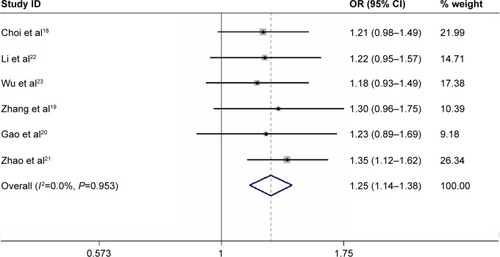
Table 2 Stratified analyses of the TERT rs2736098 G>A polymorphism on lung cancer risk
Additionally, in the analysis stratified by countries, all genetic comparison except heterozygote comparison produced significantly increased risks in the Chinese group (GA vs GG: OR =1.14, 95% CI =1.01–1.28, P=0.030, I2=0%; AA vs GG: OR =1.78, 95% CI =1.51–2.10, P<0.001, I2=0%; GA/AA vs GG: OR =1.27, 95% CI =1.14–1.41, P<0.001, I2=0%; AA vs GA/GG: OR =1.67, 95% CI =1.43–1.94, P<0.001, I2=0%). However, significant results were detected only in homozygote comparison and recessive model among Korean group (GA vs GG: OR =1.12, 95% CI =0.90–1.39, P=0.322; AA vs GG: OR =1.76, 95% CI =1.21–2.54, P=0.003; GA/AA vs GG: OR =1.21, 95% CI =0.98–1.49, P=0.072; AA vs GA/GG: OR =1.66, 95% CI =1.17–2.374, P=0.005). Considering the control source, studies with hospital-based controls showed elevated risks in three genetic comparisons (AA vs GG: OR =1.79, 95% CI =1.51–2.13, P<0.001, I2=0%; GA/AA vs GG: OR =1.27, 95% CI =1.134–1.43, P<0.001, I2=0%; AA vs GA/GG: OR =1.67, 95% CI =1.43–1.97, P<0.001, I2=0%). In the studies with population-based controls, significant associations were observed in homozygote comparison (AA vs GG: OR =1.73, 95% CI =1.28–2.35, P<0.001, I2=0%) and recessive model (AA vs GA/GG: OR =1.63, 95% CI =1.22–2.18, P=0.001, I2=0%), but not in dominant model (GA/AA vs GG: OR =1.22, 95% CI =1.02–1.45, P=0.028, I2=0%) and heterozygote comparison (GA vs GG: OR =1.12, 95% CI =0.94–1.35, P=0.214, I2=0%). In the subgroup analysis by genotype test methods, we observed significant association in three genetic comparisons (homozygote comparison, dominant model, and recessive model) in both groups using the TaqMan and PCR method ().
Test of heterogeneity
When evaluating the association between the TERT rs2736098 polymorphism and the risk of LC, we found that there was no significant heterogeneity for the heterozygote comparison (GA vs GG: Pheterogeneity=0.987, I2=0%), homozygote comparison (AA vs GG: Pheterogeneity=0.893, I2=0%), dominant model comparison (GA/AA vs GG: Pheterogeneity=0.953, I2=0%), and recessive model comparison (AA vs GA/GG: Pheterogeneity=0.946, I2=0%), which indicated that the ethnicity, control source, and genotype test methods in these six studies were similar and equilibrium.
Sensitivity analysis
To evaluate the stability of the results, we performed sensitivity analyses by deleting one single study each time in the meta-analysis, but the corresponding pooled ORs were not altered materially, suggesting that the results of our meta-analyses were statistically stable and reliable (data not shown).
Publication bias
Egger’s test and Begg’s funnel plot were carried out to assess the publication bias of our meta-analyses. Egger’s test was used to provide statistical evidence of funnel plot symmetry. Results did not show any obvious publication bias (GA/AA vs GG: P=0.491). The shape of the funnel plots revealed no evidence of obvious asymmetry ( shows the funnel plot of the overall GA/AA vs GG comparisons).
Discussion
In the current meta-analysis, we ascertained, first, that the TERT rs2736098 G>A polymorphism was significantly associated with increased risk of LC in Asians. In the subgroup analysis, significant associations were found in Chinese group and hospital-based studies. Different genotype test methods showed no influence to the final results.
The TERT gene has been mapped to chromosome 5p15.33, which consists of 16 exons and 15 introns spanning 35 kb of genomic DNA.Citation15 TERT is the rate-limiting catalytic subunit of the telomerase enzyme required for maintenance of telomere DNA length.Citation29 The length of telomeres gradually decreases with each cell division, increasing age, or mutations in structural proteins. It has been known that telomere is essential for the preservation of chromosomal integrity and stability, cellular immortality, and various carcinogeneses.Citation30–Citation32 Human telomerase activity is suppressed in most somatic tissues during differentiation but strongly upregulated in tumors. Additionally, telomerase may drive tumor progression and metastasis by activation of the glycolytic pathway.Citation33 Telomere dysfunction is an essential feature in carcinogenesis, implicating the involvement of in multiple cancers, including that of breast, head and neck, bladder, cervical, colorectal, glioma, and hepatocellular carcinoma.Citation18,Citation34–Citation39
TERT rs2736098 is localized to the second exon of the telomerase gene TERT. Zhang et alCitation40 found that the rs2736098 A allele contributed significantly to hepatocellular carcinoma risk. In a Polish study of 1,995 breast cancer cases and 2,296 controls, Savage et alCitation38 found no evidence that the TERT rs2736098 polymorphism at 5p15.33 was associated with breast cancer risk. Recently, independent GWASCitation1,Citation3,Citation6,Citation18,Citation19,Citation23 have focused on the association between TERT rs2736098 and LC risk. This SNP was first identified as a susceptibility locus for LC in a combined analysis of Icelandic and European sample sets.Citation18 More recently, a study of 501 cancer cases in Chinese women and 576 cancer-free controls also found that the variant allele of rs2736098 was significantly associated with increased risk of LC, especially in lung adenocarcinomas.Citation22
Although several studies have investigated the role of rs2736098 polymorphism in LC risk, the clinical relevance of this polymorphic gene remains inconclusive. Thus, this meta-analysis of the association between the TERT rs2736098 G>A polymorphisms and risk of LC was performed. The present meta-analysis, comprising 3,354 cases and 3,518 controls, explored the association between TERT rs2736098 polymorphisms and LC risk. It was observed that the TERT rs2736098 polymorphism was significantly correlated with increased risk of LC. In the stratified analysis by countries, control groups, and genotype test methods, similar results were found in these subgroups. Our meta-analysis proved that A allele of TERT rs2736098 G>A variant was a low-penetrant risk factor for the development of LC.
As with all meta-analyses, some limitations of our analysis might have affected the objectivity of the conclusions, which must be considered when interpreting the results. First, further evaluation of the potential interactions was limited because of the lack of original data in some studies, such as pathological subtypes of cancer. Second, unadjusted estimates were applied in our meta-analysis owing to the lack of adjusted estimates, which might have caused serious confounding bias. A more precise evaluation should be conducted if more detailed individual data become available, such as age, sex, smoking states, and histological types. Third, because all the patients in the six studies were Asians, we could not infer the risk in Europeans due to the differences in genetic backgrounds and environmental and lifestyle contexts (such as dietary habits and tobacco smoke).Citation12
In spite of certain limitations, the present meta-analysis provided significant information. First, we estimated the association conclusively between the TERT rs2736098 G>A polymorphism and LC risk, and further showed the significant association especially among Chinese rather than Korean population. This study may also provide a potential genetic marker and new insight into the etiology of LC. Second, substantial numbers of cases and controls were pooled from different studies, which significantly increased the statistical power of the analysis and made our meta-analysis more comprehensive and persuasive. Third, no heterogeneity and publication biases were detected, indicating that the results were likely reliable and unbiased.
Conclusion
In conclusion, our meta-analysis suggests that the TERT rs2736098 G>A polymorphism is associated with increased risk of LC among Asians. The insight from this study predicts the TERT rs2736098 G>A polymorphism as a potential genetic marker in the etiology of LC and will probably be a potential therapeutic target for new drugs. Nevertheless, we suggest that larger and well-designed multicentric studies including samples stratified by a genetic–environmental interaction should be carried out to fully clarify the roles of the TERT rs2736098 polymorphisms in the etiology of LC.
Acknowledgments
This work was supported by the Science and Technology Commission of Nanjing, People’s Republic of China (grant number 2014048) and the Health and Family Planning Commission of Nantong, People’s Republic of China (grant number WQ2015052).
Supplementary materials
Figure S1 Forest plot from the meta-analysis of TERT rs2736098 G>A polymorphism on lung cancer risk using heterozygote genetic model.
Abbreviations: CI, confidence interval; OR, odds ratio.
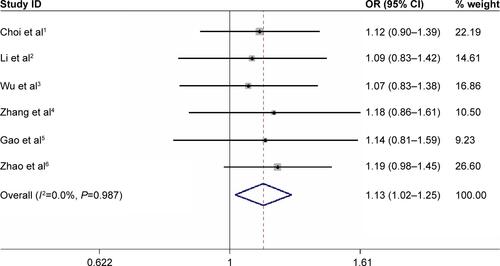
Figure S2 Forest plot from the meta-analysis of TERT rs2736098 G>A polymorphism on lung cancer risk using homozygote genetic model.
Abbreviations: CI, confidence interval; OR, odds ratio.
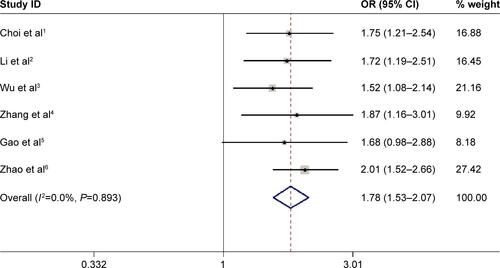
Figure S3 Forest plot from the meta-analysis of TERT rs2736098 G>A polymorphism on lung cancer risk using recessive genetic model.
Abbreviations: CI, confidence interval; OR, odds ratio.
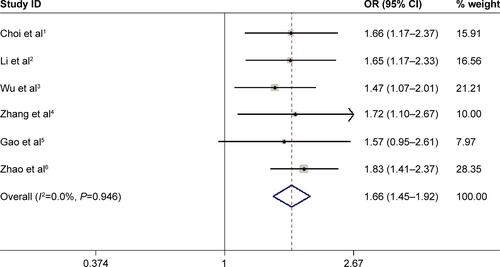
References
- ChoiJEKangHGJangJSPolymorphisms in telomere maintenance genes and risk of lung cancerCancer Epidemiol Biomarkers Prev2009182773278119773453
- LiCYinZWuWLiXRenYZhouBGenetic variations in TERT-CLPTM1L genes and risk of lung cancer in Chinese women nonsmokersPLoS One20138e6498823738012
- WuHQiaoNWangYAssociation between the telomerase reverse transcriptase (TERT) rs2736098 polymorphism and cancer risk: evidence from a case-control study of non-small-cell lung cancer and a meta-analysisPLoS One20138e7637224260099
- ZhangYZhaoMShenLGenetic polymorphisms of TERT and CLPTM1L and risk of lung cancer: a case-control study in northeast Chinese male populationMed Oncol2014311824861918
- GaoLThakurALiangYPolymorphisms in the TERT gene are associated with lung cancer risk in the Chinese Han populationEur J Cancer Prev20142349750125254308
- ZhaoMMZhangYShenLGenetic variations in TERT-CLPTM1L genes and risk of lung cancer in a Chinese populationAsian Pac J Cancer Prev2014152809281324761905
Disclosure
The authors report no conflicts of interest in this work.
References
- JemalABrayFCenterMMFerlayJWardEFormanDGlobal cancer statisticsCA Cancer J Clin201161699021296855
- SiegelRMaJZouZJemalACancer statistics, 2014CA Cancer J Clin20146492924399786
- BrawleyOWAvoidable cancer deaths globallyCA Cancer J Clin201161676821296854
- BrennanPHainautPBoffettaPGenetics of lung-cancer susceptibilityLancet Oncol20111239940820951091
- BabaHMuroKYasuiHUpdated results of the FIRIS study: a phase II/III trial of 5-FU/l-leucovorin/irinotecan (FOLFIRI) versus irinotecan/S-1 (IRIS) as second-line chemotherapy for metastatic colorectal cancer (mCRC) [abstract]J Clin Oncol2011293562
- McKayJDHungRJGaborieauVLung cancer susceptibility locus at 5p15.33Nat Genet2008401404140618978790
- LandiMTChatterjeeNYuKA genome-wide association study of lung cancer identifies a region of chromosome 5p15 associated with risk for adenocarcinomaAm J Hum Genet20098567969119836008
- WangYBroderickPWebbECommon 5p15.33 and 6p21.33 variants influence lung cancer riskNat Genet2008401407140918978787
- ThorgeirssonTEGellerFSulemPA variant associated with nicotine dependence, lung cancer and peripheral arterial diseaseNature200845263864218385739
- HungRJMcKayJDGaborieauVA susceptibility locus for lung cancer maps to nicotinic acetylcholine receptor subunit genes on 15q25Nature200845263363718385738
- AmosCIWuXBroderickPGenome-wide association scan of tag SNPs identifies a susceptibility locus for lung cancer at 15q25.1Nat Genet20084061662218385676
- HirschhornJNLohmuellerKByrneEHirschhornKA comprehensive review of genetic association studiesGenet Med20024456111882781
- JinGXuLShuYCommon genetic variants on 5p15.33 contribute to risk of lung adenocarcinoma in a Chinese populationCarcinogenesis20093098799019369581
- KangJUKooSHKwonKCParkJWKimJMGain at chromosomal region 5p15.33, containing TERT, is the most frequent genetic event in early stages of non-small cell lung cancerCancer Genet Cytogenet200818211118328944
- RafnarTSulemPStaceySNSequence variants at the TERT-CLPTM1L locus associate with many cancer typesNat Genet20094122122719151717
- ZienolddinySSkaugVLandvikNEThe TERT-CLPTM1L lung cancer susceptibility variant associates with higher DNA adduct formation in the lungCarcinogenesis2009301368137119465454
- HsiungCALanQHongYCThe 5p15.33 locus is associated with risk of lung adenocarcinoma in never-smoking females in AsiaPLoS Genet20106e100105120700438
- ChoiJEKangHGJangJSPolymorphisms in telomere maintenance genes and risk of lung cancerCancer Epidemiol Biomarkers Prev2009182773278119773453
- ZhangYZhaoMShenLGenetic polymorphisms of TERT and CLPTM1L and risk of lung cancer: a case-control study in northeast Chinese male populationMed Oncol2014311824861918
- GaoLThakurALiangYPolymorphisms in the TERT gene are associated with lung cancer risk in the Chinese Han populationEur J Cancer Prev20142349750125254308
- ZhaoMMZhangYShenLGenetic variations in TERT-CLPTM1L genes and risk of lung cancer in a Chinese populationAsian Pac J Cancer Prev2014152809281324761905
- LiCYinZWuWLiXRenYZhouBGenetic variations in TERT-CLPTM1L genes and risk of lung cancer in Chinese women nonsmokersPLoS One20138e6498823738012
- WuHQiaoNWangYAssociation between the telomerase reverse transcriptase (TERT) rs2736098 polymorphism and cancer risk: evidence from a case-control study of non-small-cell lung cancer and a meta-analysisPLoS One20138e7637224260099
- CochranWGThe comparison of percentages in matched samplesBiometrika19503725626614801052
- HigginsJPThompsonSGDeeksJJAltmanDGMeasuring inconsistency in meta-analysesBMJ200332755756012958120
- MantelNHaenszelWStatistical aspects of the analysis of data from retrospective studies of diseaseJ Natl Cancer Inst19592271974813655060
- DerSimonianRLairdNMeta-analysis in clinical trialsControl Clin Trials198671771883802833
- EggerMDavey SmithGSchneiderMMinderCBias in meta-analysis detected by a simple, graphical testBMJ19973156296349310563
- LantuejoulSSalonCSoriaJCBrambillaETelomerase expression in lung preneoplasia and neoplasiaInt J Cancer20071201835184117311257
- WeinrichSLPruzanRMaLReconstitution of human telomerase with the template RNA component hTR and the catalytic protein subunit hTRTNat Genet1997174985029398860
- FeldserDMHackettJAGreiderCWTelomere dysfunction and the initiation of genome instabilityNat Rev Cancer2003362362712894250
- RodierFKimSHNijjarTYaswenPCampisiJCancer and aging: the importance of telomeres in genome maintenanceInt J Biochem Cell Biol20053797799015743672
- BagheriSNosratiMLiSGenes and pathways downstream of telomerase in melanoma metastasisProc Natl Acad Sci U S A2006103113061131116847266
- ChenHChenYZhaoYAssociation of sequence variants on chromosomes 20, 11, and 5 (20q13.33, 11q23.3, and 5p15.33) with glioma susceptibility in a Chinese populationAm J Epidemiol201117391592221350045
- Gago-DominguezMJiangXContiDVGenetic variations on chromosomes 5p15 and 15q25 and bladder cancer risk: findings from the Los Angeles-Shanghai bladder case-control studyCarcinogenesis20113219720221081471
- HoferPBaierlABernhartKAssociation of genetic variants of human telomerase with colorectal polyps and colorectal cancer riskMol Carcinog201251suppl 1E176E18222495810
- LiuZLiGWeiSGenetic variations in TERT-CLPTM1L genes and risk of squamous cell carcinoma of the head and neckCarcinogenesis2010311977198120802237
- SavageSAChanockSJLissowskaJGenetic variation in five genes important in telomere biology and risk for breast cancerBr J Cancer20079783283617848914
- WangSWuJHuLCommon genetic variants in TERT contribute to risk of cervical cancer in a Chinese populationMol Carcinog201251suppl 1E118E12222228261
- ZhangCTianYPWangYGuoFHQinJFNiHhTERT rs2736098 genetic variants and susceptibility of hepatocellular carcinoma in the Chinese population: a case-control studyHepatobiliary Pancreat Dis Int201312747923392802


